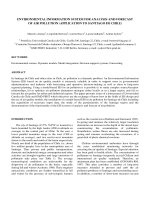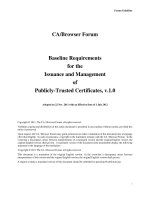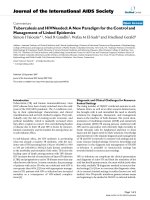Multi agent system for control and management of distributed power systems
Bạn đang xem bản rút gọn của tài liệu. Xem và tải ngay bản đầy đủ của tài liệu tại đây (5.06 MB, 245 trang )
MULTI-AGENT SYSTEM FOR CONTROL AND
MANAGEMENT OF DISTRIBUTED POWER SYSTEMS
THILLAINATHAN LOGENTHIRAN
NATIONAL UNIVERSITY OF SINGAPORE
2012
MULTI-AGENT SYSTEM FOR CONTROL AND
MANAGEMENT OF DISTRIBUTED POWER SYSTEMS
THILLAINATHAN LOGENTHIRAN
(B.SC., UNIVERSITY OF PERADENIYA, SRI LANKA)
A THESIS SUBMITTED
FOR THE DEGREE OF DOCTOR OF PHILOSOPHY
DEPARTMENT OF
ELECTRICAL AND COMPUTER ENGINEERING
NATIONAL UNIVERSITY OF SINGAPORE
MARCH, 2012
i
ACKNOWLEDGEMENTS
There are number of people I wish to thank for their help and support throughout the
course of my Ph.D. program. Foremost, I would like to express my sincere gratitude
to my mentor Dr. Dipti Srinivasan for giving me an opportunity to be her Ph.D.
student. Her insights, suggestions and guidance helped me sharpen my research skills
and her inspiration, patience and encouragement helped me conquer the difficulties
and complete my Ph.D. program successfully.
I am grateful to Siemens AG for awarding me with top honours in the Siemens Smart
Grid Innovation Contest, 2011. The award brightened my research and arouses the
expectation of my thesis by leading smart grid industries and research institutes.
Further, I wish to thank the Principal Investigator (PI), all Co-PIs and colleagues of
MODERN (Modular Distributed Energy Resource Network) project which was
carried out under the IEDS (Intelligent Energy Distribution Systems) program with
the aid of A*STAR (Science and Engineering Research Council of the Agency for
Science, Technology and Research). Special thanks to the PI, Dr. Ashwin M.
Khambadkone for his valuable guidance that aided me to carry out my tasks
confidently. I would also like to thank the PI, all Co-PIs and colleagues of
Computational Tools for Optimal Planning and Scheduling of Distributed Renewable
Energy Sources project which was carried out with the aid of NRF (National Research
Foundation).
I express my gratitude to Mr. Seow Hung Cheng for his willingness to help me at the
Energy Management and Microgrid Laboratory. I also wish to thank my colleagues
and friends for their support at the lab. Furthermore, I express my sincere gratitude to
National University of Singapore (NUS) for giving me the opportunity to pursue my
graduate studies and granting me the NUS research scholarship. I wish to thank the
ii
department of Electrical and Computer Engineering for providing me with
sophisticated laboratory facilities and tremendous support. I am also thankful to the
department for giving me an opportunity of being a part-time tutor.
I wish to express my humble gratitude to my family members and friends for their
support throughout the course of my research. Last but not least, I wish to thank the
almighty GOD, and my spiritual Gurus Siva Yogaswami and Swami Sri
Paramahamsa Nithyananda for their enduring grace and love.
i
TABLE OF CONTENTS
Abstract ix
List of Figures xii
List of Tables xvii
List of Abbreviations xix
1. Introduction 1
1.1. Overview 1
1.2. Power System Control 2
1.2.1. Centralized Control System 2
1.2.2. Distributed Control System 3
1.3. Smart Grid 5
1.4. Distributed Power Systems 7
1.4.1. Microgrid 8
1.4.2. Integrated Microgrid 9
1.5. Distributed Power System Control and Management 10
1.6. Proposed Control and Management Methodology 12
1.7. Main Research Objectives 14
1.8. Main Research Contributions 15
1.9. Dissertation Outline 16
2. Background and Related Work 17
2.1. Overview 17
ii
2.2. Multi-Agent System 17
2.2.1. Characteristics of Multi-Agent System 18
2.2.2. Advantages of Multi-Agent System 20
2.3. Multi-Agent System Development 21
2.3.1. Multi-Agent System Design 21
2.3.2. Multi-Agent System Architecture 23
2.3.3. Intelligent Agent Design 25
2.3.4. Multi-Agent System Platform 26
2.3.5. Industrial Standards 28
2.3.6. Agent Communication Languages 29
2.3.7. Ontology Design 30
2.3.8. Technical Challenges and Problems 32
2.4. Applications of Multi-Agent System in Power Systems 33
2.4.1. Modern Power System Operation 33
2.4.2. Monitoring and Diagnostic Functions 34
2.4.3. Power System Protection 35
2.4.4. Reconfiguration and Restoration 36
2.5. Applications of Multi-Agent System in Smart Grid Development 37
2.5.1. Distributed Energy Resource Modeling 37
2.5.2. Energy Market 37
2.5.3. Microgrid Operation 38
iii
2.5.4. Computer-Based Simulation Studies 38
2.5.5. Studies on Real Test Systems 39
2.6. Summary 40
3. Proposed Multi-Agent System for Distributed Power Systems 42
3.1. Overview 42
3.2. Proposed Multi-Agent System 43
3.2.1. Proposed Control Architecture 43
3.2.2. Proposed Multi-Agent System Architecture 45
3.2.3. Agents in Multi-Agent System 47
3.2.4 Security Manager Agent 50
3.3. Implementation of Multi-Agent System 52
3.4. Interface with Power System Simulators 54
3.4.1. Power World Simulator 54
3.4.2. Real-Time Digital Simulator 55
3.4.2.1. RTDS Hardware 56
3.4.2.2. RTDS Software 56
3.4.2.3. Component Model Libraries 57
3.4.2.4. Interface with RTDS 57
3.5. Proposed Demand Side Management 58
3.5.1. Demand Side Management Techniques 58
3.5.2. Demand Side Management in Smart Grid 59
3.5.3. Proposed Load Shifting Technique 60
iv
3.6. Proposed Generation Scheduling 63
3.6.1. Cooperative Microgrid Environment 63
3.6.1.1. Grid-Connected Mode Operation 64
3.6.1.2. Islanded Mode Operation 68
3.6.2. Competitive Microgrid Environment 69
3.6.2.1. PoolCo Market 69
3.6.2.2. Proposed Market Operation 71
3.6.3. Integrated Microgrid Environment 72
3.6.3.1. Bidding Strategy of Microgrid 73
3.6.3.2. Islanded Integrated Microgrid Operation 74
3.6.3.3. Grid-Connected Integrated Microgrid Operation 75
3.7. Development of Decision Making Modules 77
3.7.1. SC Agent 77
3.7.2. DSM Agent 81
3.7.3. Security Agent 85
3.8. Summary 85
4. Day-Ahead Simulations of Distributed Power Systems 87
4.1. Overview 87
4.2. Competitive Microgrid Operation 87
4.2.1. Multi-Agent System Launching 88
4.2.2. Registering with Directory Facilitator 88
4.2.3. Registering with Security Services 89
v
4.2.4. Coordination of Agents 90
4.2.5. Mitigating Violation and Congestion 92
4.2.6. Simulation Studies 93
4.2.7. Simulation Results 95
4.2.8. Discussions 96
4.3. Cooperative Microgrid Operation 97
4.3.1. Coordination of Agents 97
4.3.2. Simulation Studies 98
4.3.2.1. Residential Microgrid 103
4.3.2.2. Commercial Microgrid 104
4.3.2.3. Industrial Microgrid 106
4.3.3. Simulation Results 107
4.3.3.1. Residential Microgrid 107
4.3.3.2. Commercial Microgrid 108
4.3.3.3. Industrial Microgrid 109
4.3.4. Discussions 110
4.4. Grid-Connected Integrated Microgrid Operation 113
4.4.1. Coordination of Agents 114
4.4.2. Simulation Studies 115
4.4.3. Simulation Results 118
4.4.4. Discussions 121
4.5. Islanded Integrated Microgrid Operation 122
vi
4.5.1. Coordination of Agents 122
4.5.2. Simulation Studies 124
4.5.3. Simulation Results 128
4.5.4. Discussions 131
4.6. Summary 132
5. Real-Time Simulations of Microgrid Management 134
5.1. Overview 134
5.2. Proposed Operational Architecture 134
5.3. Real-Time Scheduling Problem 136
5.4. Coordination of Agents 136
5.5. Simulation Studies 138
5.6. Simulation Results 141
5.6.1. Grid-Connected Microgrid Operation 142
5.6.2. Islanded Microgrid Operation 143
5.7. Summary 145
6. Management of PHEV and Distributed Energy Storage Systems 146
6.1. Overview 146
6.2. Management of Electrical Vehicles 146
6.2.1. Short-Term Management of EVs: Problem Formulation 147
6.2.2. Multi-Agent System for Electrical Vehicle Management 181
6.2.2.1. Agents in Multi-Agent System 148
6.2.2.2. Coordination of Agents 149
vii
6.2.3. Simulation Studies 152
6.2.4. Simulation Results 152
6.2.5. Discussions 153
6.3. Management of Distributed Energy Storage Systems 154
6.3.1. Distributed Energy Storage Systems 154
6.3.2. Storage Technologies, Technical Roles and Financial Benefits 155
6.3.3. Proposed Operational Architecture for DESS 156
6.3.4. Short-Term Management of DESS: Problem Formulation 158
6.3.5. Proposed Methodology 159
6.3.6. Simulation Studies 161
6.3.7. Simulation Results 162
6.4. Summary 162
7. Optimal Sizing and Placement of Distributed Energy Resources 164
7.1. Overview 164
7.2. Optimal Sizing of Distributed Energy Resources 164
7.2.1. Problem Formulation 165
7.2.2. Modeling of Distributed Energy Resources 167
7.2.2.1. Photovoltaic System 167
7.2.2.2. Wind Turbine 168
7.2.2.3. Composite Energy Storage System 169
7.2.3. Reliability Measure 169
7.2.4. Proposed Methodology 173
viii
7.2.5. Simulation Studies 175
7.2.5.1. Simulation System 175
7.2.5.2. Simulation Results 181
7.2.5.3. Discussions 183
7.3. Optimal Placement of Distributed Generators 185
7.3.1. Global Performance Index 186
7.3.2. Simulation Study 191
7.4. Summary 192
8. Conclusions and Future Work 193
8.1. Overall Conclusions 193
8.2. Main Contributions 194
8.3. Future Research Work 195
Appendix 198
The Ideas for the Siemens Smart grid Innovation Idea Contest 198
List of Awards and Achievements 203
List of Publications 204
Bibliography 208
ix
ABSTRACT
The operation of modern power systems that focus on smart grid has become
complicated with the introduction of distributed generation, load control, market
operation, complex distribution networks and vehicle to grid interconnection. Smart
grid represents a vision of the future power systems and integrates advanced sensing
technologies, control methodologies and communication technologies into existing
electricity grid at transmission and distribution levels. Hence, new control and
management paradigms and technologies that are different from the traditional
methodologies are necessary for the operation of modern power systems.
In this dissertation, a decentralized control and energy management architecture based
on intelligent Multi-Agent System (MAS) is proposed for the operation of modern
distributed power systems. Intelligent multi-agent system is a distributed
Computational Intelligence (CI) technique that has been applied to solve several
power system problems such as market operation, condition monitoring, fault
diagnosis, power system restoration and protection. This technology has a great
potential to solve problems in the control and management of modern power systems
that implement smart grid techniques. In order to validate and evaluate the
effectiveness of the proposed multi-agent system, several simulation studies on the
control and management of modern distributed power systems were carried out.
This dissertation mainly focuses on the following aspects.
A decentralized control and energy management architecture that is very much
suitable for the smart grid development is proposed with intelligent multi-
agent system approach.
x
Multi-agent simulation platform is developed for the control and energy
management of distributed power systems based on IEEE FIPA standards
using JADE.
Simulation studies on the control and management of distributed power
systems with microgrids and integrated microgrids operating in different types
of environments were carried out. Several algorithms were developed and
implemented to optimize the functions of control and management.
A real-time multi-agent system was developed to carry out real-time
simulation studies on microgrid energy management. The real-time simulation
studies were tested and validated with a Real Time Digital Simulator (RTDS).
Novel methodologies are proposed for optimal sizing and placement of
distributed energy resources in distributed power systems. Most of the
simulation systems and case studies carried out in this dissertation were
optimally found out using these proposed methodologies.
Finally, management of distributed energy storage system and plug-in hybrid
electrical vehicles was carried out for opening up the future research
opportunities in context of distributed smart grid.
The outcome of the various simulation studies show that the developed multi-agent
system handles the interaction among the control entities, provides a two-way
communication channel for the entities in the distributed power systems, and makes
some decisions locally to provide more reliable electricity supply to customers.
Decision making of agents, in the multi-agent system which were developed using
mathematical and computational intelligence techniques, show the applications and
effectiveness of computational intelligence techniques for smart grid development.
Furthermore, the real-time simulation studies on the smart microgrid at the
xi
distribution network level show that multi-agent system can also handle real-time
dynamic events while implementing smart grid techniques for the future power
systems.
xii
LIST OF FIGURES
Figure 1.1. Schematic representation of a centralized control system 3
Figure 1.2. Schematic representation of a decentralized control system 4
Figure 1.3. Schematic diagram of a microgrid 9
Figure 1.4. Schematic diagram of an integrated microgrid 10
Figure 2.1. Design stages of multi-agent system 22
Figure 2.2. Layered architecture of multi-agent system 23
Figure 2.3. Layered agent anatomy 26
Figure 2.4. FIPA agent management reference model 28
Figure 2.5. Interaction of agents for FIPA contract-net protocol 29
Figure 2.6. Class hierarchy of a part of an upper ontology based on CIM 31
Figure 3.1. Schematic diagram of MAS - Microgrid 43
Figure 3.2. Control architecture for distributed power system with microgrids 44
Figure 3.3. Layered architecture for a microgrid agent 45
Figure 3.4. Generic architecture of an intelligent agent 47
Figure 3.5. Security architecture of an agent world 51
Figure 3.6. Structure of software packages 52
Figure 3.7. MicroGridOntology 53
Figure 3.8. Interface between Power World Simulator and MAS (Java) 55
Figure 3.9. Interface between RTDS and MAS (Java) 57
Figure 3.10. Demand side management techniques 58
Figure 3.11. Illustration of Connected(t) 61
xiii
Figure 3.12. Illustration of Disconnected(t) 62
Figure 3.13. Schematic diagram of a microgrid 64
Figure 3.14. PoolCo market model 70
Figure 3.15. PoolCo market clearing algorithm 71
Figure 3.16. Proposed market operation 72
Figure 3.17. Proposed scheduling for islanded integrated microgrid 74
Figure 3.18. Proposed scheduling for grid-connected integrated microgrid 75
Figure 3.19. LREA for thermal unit commitment problem 80
Figure 3.20. Proposed evolutionary algorithm 83
Figure 4.1. Initialization of multi-agent system 88
Figure 4.2. Registration and query of agents 89
Figure 4.3. Role of security manager agent 89
Figure 4.4. Interaction of agents for competitive microgrid operation 90
Figure 4.5. Network diagram of the microgrid 92
Figure 4.6. Excess demand at MCP 94
Figure 4.7. Excess supply at MCP 94
Figure 4.8. Perfect matching of supply and demand at MCP 94
Figure 4.9. Demonstration of multi-agent system 96
Figure 4.10. Interaction of agents for cooperative microgrid operation 98
Figure 4.11. Network diagram of the residential microgrid 103
Figure 4.12. Network diagram of the commercial microgrid 105
Figure 4.13. Network diagram of the industrial microgrid 106
Figure 4.14. DSM results of the residential microgrid 107
xiv
Figure 4.15. Generation scheduling of the residential microgrid 108
Figure 4.16. DSM results of the commercial microgrid 108
Figure 4.17. Generation scheduling of the commercial microgrid 109
Figure 4.18. DSM results of the industrial microgrid 109
Figure 4.19. Generation scheduling of the industrial microgrid 110
Figure 4.20. Schematic diagram of an integrated microgrid 114
Figure 4.21. Interaction of agents for grid-connected integrated microgrid 115
Figure 4.22. Electrical network diagram of the integrated microgrid 116
Figure 4.23. Hourly wholesale energy prices 117
Figure 4.24. Hourly forecasted load demands 117
Figure 4.25. Load demands after load shifting 118
Figure 4.26. Power exchanges among the control entities 119
Figure 4.27. Generation scheduling of the residential microgrid 119
Figure 4.28. Generation scheduling of the commercial microgrid 120
Figure 4.29. Generation scheduling of the industrial microgrid 120
Figure 4.30. Schematic diagram of an islanded distributed power system 122
Figure 4.31. Coordination of agents for islanded integrated microgrid 123
Figure 4.32. Electrical network diagram of the distributed power system 124
Figure 4.33. Forecasted load demands of each microgrid and lumped load 127
Figure 4.34. Forecasted market prices of each microgrid and lumped load 127
Figure 4.35. Bid Quantities (BQ) of each microgrid and lumped load 128
Figure 4.36. Power settings of DERs and load demand of the microgrid A 129
Figure 4.37. Power settings of DERs and load demand of the microgrid B 129
xv
Figure 4.38. Power settings of DERs and load demand of the microgrid C 130
Figure 4.39. Market clearing prices 130
Figure 4.40. Successful Bid Quantities (SBQ) of each microgrid and lumped load . 131
Figure 5.1. Proposed real-time operational architecture of microgrid 135
Figure 5.2. Interaction of agents for day-ahead scheduling 137
Figure 5.3. Interaction of agents for real-time scheduling 138
Figure 5.4. Schematic diagram of the microgrid 139
Figure 5.5. Electrical network diagram of the microgrid in RTDS 140
Figure 5.6. Load profile after load shifting 141
Figure 5.7. Day-ahead hourly schedule of the grid-connected microgrid 142
Figure 5.8. Real-time scheduling of the grid-connected microgrid 143
Figure 5.9. Day-ahead hourly schedule of the islanded microgrid 144
Figure 5.10. Real-time scheduling of the islanded microgrid 144
Figure 6.1. Schematic overview of the multi-agent system 149
Figure 6.2. Coordination of agents for management of PHEVs 150
Figure 6.3. Messages among the agents for a request of charging 151
Figure 6.4. Wholesale energy prices 152
Figure 6.5. Forecasted load profile and the resultant load profiles 153
Figure 6.6. Distributed energy storage system in smart grid 155
Figure 6.7. Proposed architecture of distributed energy storage system 157
Figure 6.8. Proposed methodology for short-term management of DESS 160
Figure 6.9. Power settings of the energy storage elements 162
Figure 7.1. Schematic representation of an integrated microgrid 166
xvi
Figure 7.2. Proposed methodology for optimal sizing 173
Figure 7.3. Schematic diagram of the integrated microgrid 176
Figure 7.4. Electrical network diagram of the integrated microgrid 177
Figure 7.5. Hourly wholesale prices 179
Figure 7.6. Hourly solar insolations 179
Figure 7.7. Hourly ambient temperatures 180
Figure 7.8. Hourly wind speeds 180
Figure 7.9. Convergence characteristic of ES for strategy 3 185
Figure 7.10. Flowchart of the proposed methodology 190
Figure 7.11. IEEE 34 node test feeder 191
xvii
LIST OF TABLES
Table 1.1. Comparison of a smart grid and a traditional grid 6
Table 4.1. Simulation results for each scenario 95
Table 4.2. Forecasted load demands and wholesale energy prices 99
Table 4.3. Forecasted hourly normalized power production of RES 100
Table 4.4. Distribution of loads in the system 101
Table 4.5. Installed capacities of distributed energy resources 102
Table 4.6. Data of controllable devices in the residential microgrid 104
Table 4.7. Data of controllable devices in the commercial microgrid 105
Table 4.8. Data of controllable devices in the industrial microgrid 106
Table 4.9. Operational cost reduction with DSM 110
Table 4.10. Peak demand reduction with DSM 112
Table 4.11. Additional cost saving from generation scheduling 113
Table 4.12. Details of DERs in the microgrids 125
Table 4.13. Data of thermal units 126
Table 5.1. Details of the distributed energy resources 139
Table 5.2. Forecasted load demands and wholesale energy prices 141
Table 6.1. Details of the energy storage elements 161
Table 6.2. Forecasted hourly wholesale energy prices and system loads 161
Table 7.1. Average energy limits of distributed energy resources 176
Table 7.2. Data of interconnection links 178
Table 7.3. Distribution of loads and distributed generators 178
xviii
Table 7.4. Cost details of distributed energy resources 181
Table 7.5. Results for the integrated microgrids with strategies 1 and 2 182
Table 7.6. Results for the integrated microgrid with strategies 3 183
Table 7.7. Weight factors for indices 190
xix
LIST OF ABBREVIATIONS
ACL Agent Communication Language
AID Agent Identifier
AMS Agent Management Service
CA Contingency Analyser
CESS Composite Energy Storage System
CI Computational Intelligence
DER Distributed Energy Resource
DESS Distributed Energy Storage System
DF Directory Facilitator
DG Distributed Generation/Distributed Generator
DMS Distribution Management System
DNO Distribution Network Operator
DSM Demand Side Management
EA Evolutionary Algorithm
ES Evolutionary Strategy
EV Electrical Vehicle
FIPA Foundation for Intelligent Physical Agents
GPI Global Performance Index
IEDS Intelligent Energy Distribution System
IEEE Institute of Electrical and Electronics Engineers
ISO Independent System Operator
xx
JADE Java Agent Development
JNI Java Native Interface
LC Local Controller/Load Controller
LMP Locational Marginal Price
LP Linear Programming
LR Lagrangian Relaxation
LREA Lagrangian Relaxation with Evolutionary Algorithm
MAS Multi-Agent System
MCP Market Clearing Price
MGC Microgrid Controller
MO Market Operator
MODERN Modular Distributed Energy Resource Network
MSC Micro Source Controller
MTS Message Transport Service
OPF Optimal Power Flow
PHEV Plug-in Hybrid Electrical Vehicle
PX Power Exchange
RMA Remote Monitoring Agent
RTDS Real-Time Digital Simulator
RTU Remote Terminal Unit
SC Schedule Coordinator
SCADA System Control And Data Acquisition
SE State Estimator
1
CHAPTER 1
INTRODUCTION
1.1. Overview
Power industry is experiencing technological innovations all around the world to
provide electricity and related services to customers at the lowest prices, through the
introduction of competition in power industry [1,2]. Restructuring of power systems is
achieved through gradual transition from centralized power generation to distributed
power generation [3-6]. Distributed Generation (DG) [4,7-9] encompasses any small-
scale electricity generation technology that generates and provides electric power
close to the consumers' premises. With the introduction of distributed power
generation, demand side management, market operation, complex distribution
networks, and many interconnections among distributed power systems and sub
systems, the operation of modern distributed power systems have become extremely
complicated. Therefore, new control and management paradigms and various
techniques that are different from those used in the past are necessary for the
operation of modern distributed power systems.
The main objective of this dissertation is to design, develop and simulate intelligent
Multi-Agent Systems (MAS) [10] that enable control and energy management of
distributed power systems. This includes the development of control and management
algorithms, optimal sizing and placement of Distributed Energy Resources (DER)
[4,5], the implementation of smart grid techniques [6,7] and management of
distributed power systems.
This chapter is organized as follows. Section 1.2 describes the distributed power
system control. Section 1.3 briefly explains the smart grid and its main characteristics.









